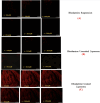Novel Chitosan-Coated Liposomes Coloaded with Exemestane and Genistein for an Effective Breast Cancer Therapy
- PMID: 38434864
- PMCID: PMC10905587
- DOI: 10.1021/acsomega.3c09948
Novel Chitosan-Coated Liposomes Coloaded with Exemestane and Genistein for an Effective Breast Cancer Therapy
Abstract
For achieving high effectiveness in the management of breast cancer, coadministration of drugs has attracted a lot of interest as a mode of therapy when compared to a single chemotherapeutic agent that often results in reduced therapeutic end results. Owing to their proven effectiveness, good patient compliance, and lower costs, oral anticancer drugs have received much attention. In the present work, we formulated the chitosan-coated nanoliposomes loaded with two lipophilic agents, namely, exemestane (EXE) and genistein (GEN). The formulation was prepared using the ethanol injection method, which is considered a simple method for getting the nanoliposomes. The formulation was optimized using Box-Behnken design (BBD) and was extensively characterized for particle size, ζ-potential, Fourier transform infrared (FTIR), differential scanning calorimetry (DSC), and X-ray diffraction (XRD) analysis. The sizes of conventional and coated liposomes were found to be 104.6 ± 3.8 and 120.3 ± 6.4 nm with a low polydispersity index of 0.399 and 0.381, respectively. The ζ-potential of the liposomes was observed to be -16.56 mV, which changed to a positive value of +22.4 mV, clearly indicating the complete coating of the nanoliposomes by the chitosan. The average encapsulation efficiency was found to be between 70 and 80% for all prepared formulations. The compatibility of the drug with excipients and complete dispersion of the drug inside the system were verified by FTIR, XRD, and DSC studies. Furthermore, the in vitro release studies concluded the sustained release pattern following the Korsmeyer-Peppas model as the best-fitting model with Fickian diffusion. Ex vivo studies showed better permeation of the chitosan-coated liposomes, which was further confirmed by confocal studies. The prepared chitosan-coated liposomes showed superior antioxidant activity (94.56%) and enhanced % cytotoxicity (IC50 7.253 ± 0.34 μM) compared to the uncoated liposomes. 3-(4,5-Dimethylthiazol-2-yl)-2,5-diphenyltetrazolium bromide (MTT) assay displayed better cytotoxicity of the chitosan-coated nanoliposomes compared to the plain drug, showing the better penetration and enhanced bioavailability of drugs inside the cells. The formulation was found to be safe for administration, which was confirmed using the toxicity studies performed on an animal model. The above data suggested that poorly soluble lipophilic drugs could be successfully delivered via chitosan-coated liposomes for their effective delivery in breast cancer.
© 2024 The Authors. Published by American Chemical Society.
Conflict of interest statement
The authors declare no competing financial interest.
Figures














Similar articles
-
Formulation of Piperine-Chitosan-Coated Liposomes: Characterization and In Vitro Cytotoxic Evaluation.Molecules. 2021 May 29;26(11):3281. doi: 10.3390/molecules26113281. Molecules. 2021. PMID: 34072306 Free PMC article.
-
Bioadhesive Chitosan-Coated Cationic Nanoliposomes With Improved Insulin Encapsulation and Prolonged Oral Hypoglycemic Effect in Diabetic Mice.J Pharm Sci. 2018 Aug;107(8):2136-2143. doi: 10.1016/j.xphs.2018.04.011. Epub 2018 Apr 22. J Pharm Sci. 2018. PMID: 29689252
-
Preparation and evaluation of a novel oral delivery system for low molecular weight heparin.Int J Pharm Investig. 2016 Jul-Sep;6(3):148-57. doi: 10.4103/2230-973X.187351. Int J Pharm Investig. 2016. PMID: 27606258 Free PMC article.
-
Probing nanoliposomes using single particle analytical techniques: effect of excipients, solvents, phase transition and zeta potential.Heliyon. 2018 Dec 26;4(12):e01088. doi: 10.1016/j.heliyon.2018.e01088. eCollection 2018 Dec. Heliyon. 2018. PMID: 30603716 Free PMC article. Review.
-
PEGylated Nanoliposomes Encapsulated with Anticancer Drugs for Breast and Prostate Cancer Therapy: An Update.Pharmaceutics. 2025 Feb 4;17(2):190. doi: 10.3390/pharmaceutics17020190. Pharmaceutics. 2025. PMID: 40006557 Free PMC article. Review.
Cited by
-
Emerging nanostructure-based strategies for breast cancer therapy: innovations, challenges, and future directions.Med Oncol. 2025 Apr 30;42(6):188. doi: 10.1007/s12032-025-02743-z. Med Oncol. 2025. PMID: 40307624 Review.
-
Synergistic Enhancement of Carboplatin Efficacy through pH-Sensitive Nanoparticles Formulated Using Naturally Derived Boswellia Extract for Colorectal Cancer Therapy.Pharmaceutics. 2024 Sep 30;16(10):1282. doi: 10.3390/pharmaceutics16101282. Pharmaceutics. 2024. PMID: 39458611 Free PMC article.
-
Harnessing Polyphenols and Novel Delivery Strategies for Effective Treatment of Breast Cancer.Recent Adv Drug Deliv Formul. 2025;19(2):127-141. doi: 10.2174/0126673878329992250112190329. Recent Adv Drug Deliv Formul. 2025. PMID: 39865821 Review.
-
Comparative In Vitro Study between Biocompatible Chitosan-Based Magnetic Nanocapsules and Liposome Formulations with Potential Application in Anti-Inflammatory Therapy.Int J Mol Sci. 2024 Aug 2;25(15):8454. doi: 10.3390/ijms25158454. Int J Mol Sci. 2024. PMID: 39126023 Free PMC article.
-
Innovative approaches in breast cancer therapy: repurposing nanocarriers for enhanced outcomes.Naunyn Schmiedebergs Arch Pharmacol. 2025 Apr 1. doi: 10.1007/s00210-025-04012-2. Online ahead of print. Naunyn Schmiedebergs Arch Pharmacol. 2025. PMID: 40167629 Review.
References
-
- Anderson B. O.; Ilbawi A. M.; Fidarova E.; Weiderpass E.; Stevens L.; Abdel-Wahab M.; Mikkelsen B. The Global Breast Cancer Initiative: A Strategic Collaboration to Strengthen Health Care for Non-Communicable Diseases. Lancet Oncol. 2021, 22 (5), 578–581. 10.1016/S1470-2045(21)00071-1. - DOI - PubMed
-
- Kawish S. M.; Hasan N.; Beg S.; Qadir A.; Jain G. K.; Aqil M.; Ahmad F. J. Docetaxel-Loaded Borage Seed Oil Nanoemulsion with Improved Antitumor Activity for Solid Tumor Treatment: Formulation Development, in Vitro, in Silico and in Vivo Evaluation. J. Drug Delivery Sci. Technol. 2022, 75, 10369310.1016/j.jddst.2022.103693. - DOI
LinkOut - more resources
Full Text Sources
